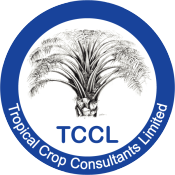In-field fruit transport is a major issue for oil palm growers. The key to efficient in-field crop transport is to install paths, either in alternate inter-rows (wheelbarrow transport, 60–70 palms per path) or every fourth row (mechanical or draft animal transport, 120–140 palms/path). In hilly country, in-field access may be provided via planting terraces or contour paths. Paths should be well-drained with bridges/culverts to provide crossing points and turning points. The surface should be smooth enough to allow unimpeded access by the respective vehicle.
Many different machines have been tried, ranging from mechanical buffaloes (with wheels or tracks) to mini-tractors and trailers (with/without a mechanical grabber crane). The output of most mechanical methods ranges from 20–40 t/day but usually a driver plus two loaders is required. So the output per worker is 7–13 t/md.
Buffalo carts (light weight steel frame with fibreglass body) achieve outputs of 8–12 t/md with one worker (no driver required). Fruit bunches can be spike loaded or tipped into a skip bin positioned on collection roads. As a general rule, draft animals should not pull a cart weighing more than 1.5 times their body weight. Therefore, a sample of animals and empty carts should be weighed to establish cart loading limits.
For work in steep terrain, where tractors cannot pass, buffaloes can be equipped with panniers and achieve outputs of 5–7 t/md. Similarly, mules equipped with lightweight panniers can achieve outputs of 2–3 t/md. In both cases, no driver is required as the draft animal responds to voice commands from the loader.
Where draft animal in-field crop collection is practised it makes sense to separate bunch cutting, loose fruit collection and crop and loose fruit transport.
Many companies find a combination of draft animal transport and some mechanical collection is best where mechanical collection provides flexibility to cope with large volumes of fruit bunches during the peak season.
Wherever animal traction is used at scale, a veterinarian must be employed to manage draft animal health, nutrition and proper deployment.
- Prevent the occurrence of harness pressure sores by using clean, well adjusted harnesses.
- Use lightweight carts and panniers to reduce the load on the draft animal.
- Mules and buffaloes should be allowed to rest on alternate days. Thus, an operator is usually allocated two animals with one working and one resting each day. Draft animals should be ear tagged or branded (e.g., animals with yellow ear tags/brand #1 work Monday, Wednesday, Friday, animals with ear blue tags/brand #2 work Tuesday, Thursday, Saturday).
- Palm kernel expeller (PKE) can be used as an animal feed supplement. PKE must be sieved to remove poorly-ground kernels and shell fragments and other contaminants. PKE should be introduced gradually to the diet of mules (mono gastric animals). Mules and buffaloes can be fed a maximum of about 1 kg PKE/animal/day to supplement fodder (grass, legume cover plants).
- Buffaloes must be provided with grazing and wallow areas within their enclosure. Mules should be housed in a roofed enclosure with a concrete floor.
- All draft animals should be provided with free access to water and mineral salt blocks.
